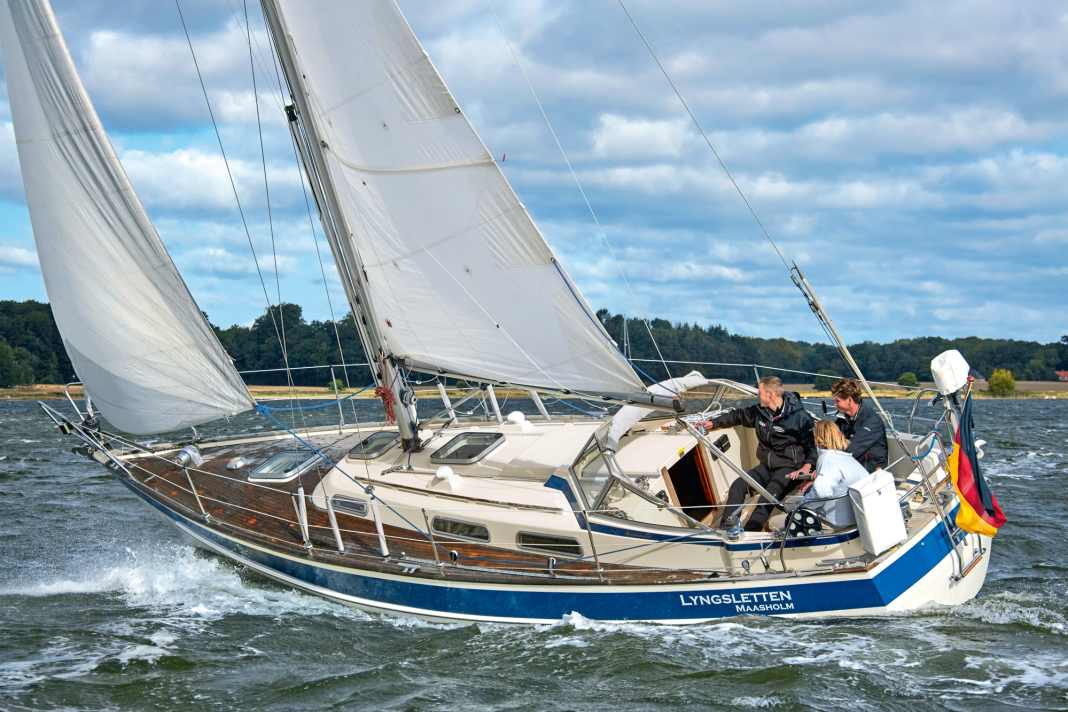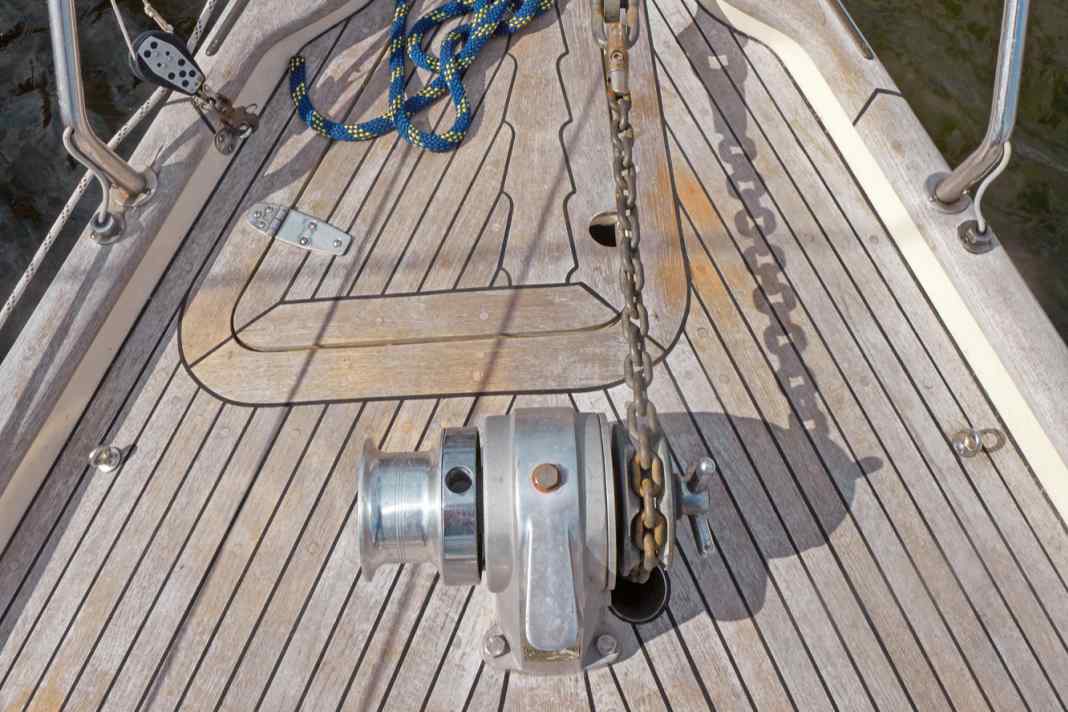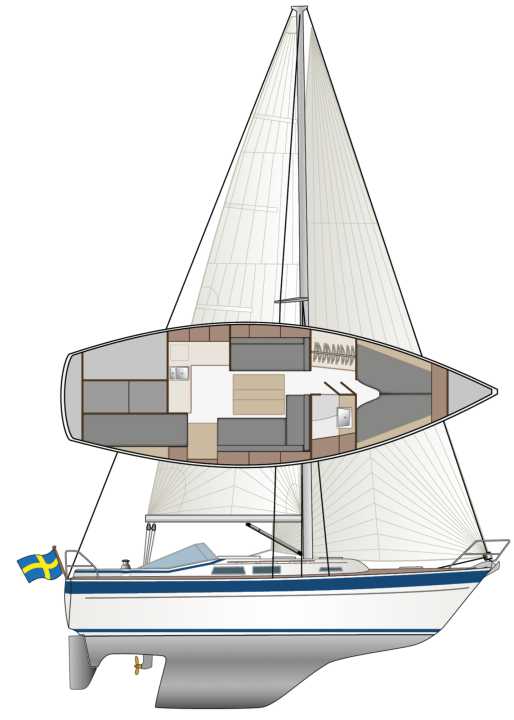





When the shimmering brownish water on the Maasholmer Noor is adorned with streaks of white foam and the seagulls screech excitedly as they fly sideways rather than straight ahead, then it's time to tie a reef to the main.
On the Hallberg-Rassy 312, the owners are content with not fully unfurling the genoa. The ship can handle that. And indeed, with a little more leeway than the cruising sailor would accept for a longer period of time, the Swedish-born boat pushes off and still lies comfortably on the rudder. You can even let go of it for a short time, and there is no sign of windward yaw even in the prevailing 5 to 6 Beaufort.
Also interesting:
The quiet movements make it easy to move around on and below deck, the ship quickly becomes a familiar living space even for newcomers on board, because everything is where it belongs and no unknown things want to be explored, anyway, it quickly becomes clear that the 312 does not give up any secrets to its crew.
It's easy to imagine that you can sail comfortably under such conditions - even when the going gets tough. With its moderate long keel and high ballast ratio, the 312 is good-natured. With her deep V-frame, she enters the waves smoothly. The resulting calm movements in rough conditions give the feeling of being on a much larger ship.
The boat was long regarded as a very good sailing 31-footer, even in light winds. If it blows at more than 10 knots, or even as strong as today, it starts to run. But above all, the sailing day is an uncomplicated experience despite the stiff breeze. The boat is easy to handle from the cockpit, the helmsman has everything under control and can handle the sail controls well on deck alone. The cockpit with the fixed windscreen, which became the shipyard's trademark early on, is compact. The latter can be opened in the centre, which ensures good ventilation at anchor.
The vertical coamings in the back are a nuisance when the boat is in a very long position, and more than three adults would sit in the way for a long time in the 1.95 metre long cockpit, the aft half of which is reserved for the helmsman. The arrangement of the already too short traveller, namely where the tiller ends, is disturbing. The helmsman has to move under the tiller when tacking and jibing because there is no room for him between the main bulkhead and the tiller. After a successful manoeuvre, the seating position is excellent, the spacing of the dents makes it possible to support oneself and the view to the front is unobstructed.
Long model history
When the 312 was launched in 1979, it inherited a heavy legacy. Her predecessor, the Hallberg-Rassy 31 Monsun, matched her in terms of dimensions, equipment and the requirement to fulfil the wishes of more demanding owners. With 904 units built, she is the shipyard's best-selling model to date. In the year of the model change, a 31-foot yacht was by no means considered an entry-level class. There was still a smaller boat in the range, the HR 26. And in 1980, YACHT judged that the 312 could be comfortably sailed by a crew of four who occasionally wanted to take two guests with them.
Almost forty years later, it is not only the figures that prove the success of shipyard boss Christoph Rassy and in-house designer Olle Enderlein. The 312 is still in demand today, as the stable used boat price clearly shows.
"The Hallberg Rassy 312 is one of the shipyard's most popular ships," says the owner of the test ship. In 14 years of construction between 1979 and 1993, 690 sister ships were delivered. Apart from the Monsun, only two models have sold better to date. He knows the model history inside out. "There are three versions of the 312. Two of them can be found in the MK I version built until 1986, recognisable by the hull windows, and the third in the later MK II version with the windows in the superstructure."
The toilet area, for example, is different. The floor, which was initially made of wood in the segment between the forward berths and saloon of the MK I version, was replaced at some point by a GRP shell, and in the MK II version a separate wet room with shower was finally installed, the waste water from which is channelled into the one metre deep bilge sump. The length of the forward berths also varies - from 200 centimetres in the oldest to 190 centimetres in the latest version.
The superstructure was extended aft as part of the model upgrade, so the cockpit was moved slightly aft and widened at the same time. The galley and navigation were made somewhat more spacious by the longer superstructure. In the MK-II boats, a dog bunk, which was previously only available as an extra, is also attached to the latter.
Incidentally, the shipyard did not fulfil many extra requests. This was criticised in earlier tests, but was an understandable strategy on the part of the shipyard as a concession to a large series of high-quality craftsmanship, and today offers used boat buyers the advantage of good comparability between the boats.
Although the hull shell and rigging were never touched, the deck mould had to be rebuilt for the model upgrade. In the process, the shipyard also raised the beam bay, resulting in an almost Waldeck-like round shape and thus more headroom below deck. In the saloon of the MK-II version, it is 1.87 metres. Visually, the older version with the windows in the hull looks a little more elongated, says owner Horstbrink, but many people like his boat better because the windows are in the superstructure, which also provides more light below deck. But no matter which version, the lines are considered timeless by many observers today.
Problematic teak deck
This is visually emphasised by the teak deck. It had to be ordered as an extra, but hardly any buyer did without it. However, it was not fully bonded and, depending on the degree of use, will sooner or later become a problem area. Used boats on which this has already been professionally repaired are therefore extremely attractive.
This is particularly true of the 312, as the deck area is large in relation to the length of the boat. However, this is a considerable advantage of the 312. Wide running decks, which are bordered by a high coaming, and the low superstructure turn the deck into additional living space and a spacious work area on which the crew can move around safely, also thanks to the high and solidly mounted sea railing.
There is a large anchor locker on the foredeck, and a capstan behind it on the test boat, with the chain running alongside the locker lid so that it can be opened even when the harness is attached.
Sophisticated expansion
Below deck, there is a half-height bridge deck, the engine box and two companionway steps. Even years later, the matte lacquered mahogany interior exudes the ambience with which the shipyard has earned a reputation for delivering excellent craftsmanship even in large series. The only disturbing elements are the Rassy-typical formica surfaces in the galley and navigation area - but that is a matter of taste and getting used to.
The fact that Rassy was not primarily concerned with cheap mass production, but with fulfilling the dreams of discerning cruising sailors, is obvious at first glance. Whether in the practical galley on the port side, the spacious navigation area opposite or the owner's cabin in the foredeck, numerous lockers have been installed everywhere to make the boat very habitable. In the MK-II version, there is also a spacious cupboard opposite the wet room.
The galley of the test boat has a seaworthy double sink, a semi-cardanically suspended gas cooker with oven, a top-loading fridge and sufficient work space. The position next to the companionway is in the quietest area of the boat at sea. Numerous details are a joy to behold, for example the waste bin has its fixed place in the forecastle and can be reached through a hatch from the galley.
The navigator sits at the head of the extremely spacious dog bunk, which is bordered by the side wall insulated with wooden stanchions. The chart table has space for sports boat charts, and there is a panel for the electronics and a spacious bookshelf.
The conventional saloon offers longitudinal sofas to port and L-shaped sofas to starboard, arranged around a large folding table positioned in the centreline. Numerous cupboards and book shelves on each side are also standard here.
The lockers under the sofa berths, which are created by folding up the backrests, are accessible both from above and through several hatches on the side. A deck hatch behind the mast and the windows provide plenty of light and two dorade boxes on the superstructure ensure good ventilation at all times.
Compared to contemporary yachts, where this area is usually found in the wider midship region, the wet room is cramped. However, it has headroom and the shower is perfectly usable. It has a window that can be opened and an additional hatch in the superstructure that extends over the bulkhead and thus also ventilates the passage to the foredeck. Numerous lockers have also been installed in the wet room.
The foredeck gets plenty of light through a large hatch, access is via a bulkhead that has been moved slightly to starboard and is facilitated by a removable bunk triangle.
Structure
Even before the CE labelling requirement, Hallberg Rassy attached great importance to providing customers with the assurance that the good construction quality of their ship would also be confirmed by third parties. The HR 312 was therefore built "under the constant supervision of an external inspector from Lloyd's Register of Shipping". The expertise included, among other things, the assessment of the production of the hull, deck, load-bearing bulkheads, keel, steering gear, rigging, hatches and the water and fuel tanks in the keel.
The solid hull, reinforced with stringers, was injection moulded from GRP, the laminated deck from GRP sandwich. The keel is part of the hull shell and was filled from the inside with iron ballast, which was then moulded with resin and laminated over.
All bulkheads and the deck are laminated to the hull, the mast stands on the main bulkhead on deck and is additionally supported by a wooden mast foot. The jibs are bolted with solid knees that are laminated to the hull.
Typical weak points of the Hallberg-Rassy 312






The ship has a high-quality finish, but the usual signs of wear and tear should be noted
The Hallberg-Rassy 312 in detail

Technical data of the Hallberg 312
- Design engineer: Olle Enderlein
- Total length: 9,42 m
- Waterline length: 7,70 m
- Width: 3,08 m
- Depth: 1,62 m
- Displacement: 4,9 t
- Ballast/proportion: 2,2 t/45 %
- Mainsail: 19 m2
- Furling genoa: 33 m2
- Machine until 1991: Volvo Penta MD 1123 hp
- Machine from 1991: Volvo Penta 200328 hp
- Hull speed: 6.74 knots
Construction method
- Hull: solid GRP
- Deck: Sandwich
Price and shipyard
- Base price ex shipyard 1980: DM 110,000
- corresponds to today's purchasing power: 151.700 €
- Used boat prices depending on age and condition: between € 40,000 and € 65,000
As of 07/24. How the prices shown are defined can be found here!
Shipyard
Hallberg Rassy, Orust, Sweden, www.hallberg-rassy.com
YACHT review of the Hallberg-Rassy 312
With the HR 312, Olle Enderlein and Christoph Rassy have captured a timeless taste and built a stable cruising boat with good sailing characteristics. Uncomplicated and with an above-average amount of comfortable living space on and below deck.
The article first appeared in YACHT 09/2017 and has been updated for the online version.

